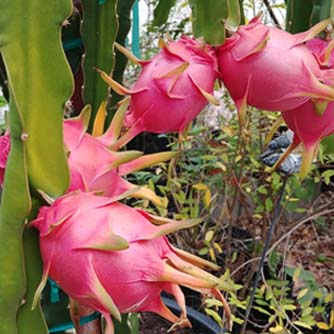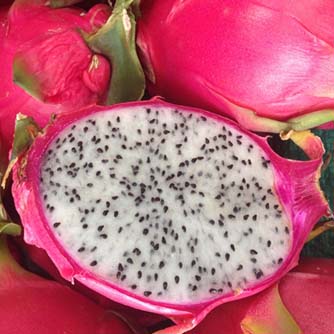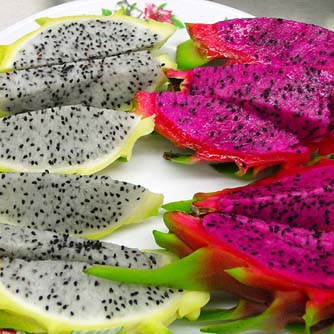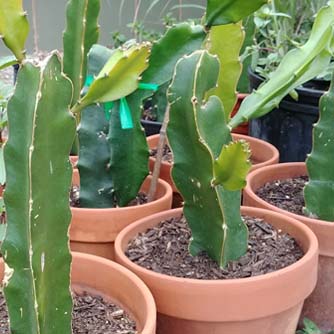Dragon Fruit
BackDragon fruit is an incredible cactus that produces strange looking fruit resembling a magical dragon egg. Cut through the vibrant pinky red skin to reveal white or pink flesh speckled with tiny black seeds. The taste is hard to pin down with some saying it’s a sweet mix of mild kiwi fruit, watermelon, strawberry and pear flavours. Others describe it as only vaguely sweet or even savoury. Confused? Well growing conditions and ripeness of the fruit can impact taste but nonetheless it’s visually impressive and packed full of nutrients, like Vitamin C, so you can’t go wrong.
If the fruit isn’t enough to you tempt you then don’t forget the flowers. Their stunning large flowers are easily over 20cm wide and appear in summer. They are yellowy green on the outside and open to a scented white, lily like bloom. Flowers open in the evening and only last one night. It’s the perfect excuse to host an evening cocktail party and enjoy their blooms!
Dragon Fruit Types
The name dragon fruit is used to refer to several types of cacti that produce edible fruits. In Australia the mostly grown species are:
- Hylocereus undatus (white fleshed fruit)
- Hylocereus costaricensis (red fleshed fruit). Also known as H. polyrhizus.
- Hylocereus megalanthus (yellow skin and white flesh)
There are also named varieties available but the good news is that regardless of what type you get they all need the same basic growing conditions.

The incredible looking dragon fruit!
How To Grow Dragon Fruit
Dragon fruits come from Mexico and Central and Southern America. Not surprisingly they like warm conditions with mild winters and no frost. They can tolerate the occasional short burst of cold weather but ideally they should be kept above 10 degrees. They can handle heat, drought, humidity and poor soils but will grow tastier fruit with regular watering and rich soil.
Choose a sunny spot and then boost the soil with compost, manure and certified organic pelletised fertiliser. A dose of lime is also beneficial. Soil needs to be free draining as these plants rot easily if the roots sit in water. Clay soils are not ideal but if that’s all you have then treat with gypsum and plant on a raised mound. Alternatively they will happily grow in a large pot.
Mulch plants to protect their shallow roots and water in with OCP eco-seaweed. Repeat the OCP eco-seaweed a week later to encourage new roots to grow quickly.

White fleshed dragon fruit is the most commonly seen type
If left to their own devices dragon fruit become a scrambling scraggy mess so a bit of training is in order. Plant against a thick stake or some other support and tie one or two main stems to the support to encourage vertical straight growth. Trim away any other side shoots. Once the stems have reached the desired height cut off their ends to encourage new branching shoots. These can then be allowed to spread out and hang downwards. Commercial growers often use a rose wheel and encourage side way branches to grow over the wheel making it easier for picking fruit.
Fertilising and Maintenance of Dragon Fruit
Every 2-3 weeks apply a mix of OCP eco-seaweed and OCP eco-aminogro as a foliar spray or watered in the soil around the plant. Each spring reapply lime and replenish the compost/manure/organic fertiliser pellets. Check the staking to ensure plant is properly supported as it grows.
When established the top can become quite congested and large. Periodically remove some of the longer shoots to keep it under control and allow space for new growth to develop. This is important because flowers form on the ends of new season growth so each year you need new growth to get fruit. Less congestion tends to lead to bigger fruit as well.

Yellow skinned and pink flesh dragon fruits are a little less common
Harvesting Dragon Fruits
Fruit is ripe approximately a month after flowering but this can vary with local conditions. Fruit will not continue to ripen once picked so you need to look for other signs before picking. Check that the colour of the fruit is bright and even all over and the small “wings” on the fruit are starting to wither. Lightly press the fruit in your hand and if ripe it will give just a little. Pick by twisting the fruit off the plant or cut with secatuers. The skin is not edible but the seeds are just like a kiwi fruit.
Propagation of Dragon Fruits
Dragon fruit grow easily from seed or cuttings. To grow from seed, squash some flesh onto paper towel and keep moist in a warm position but away from direct sunlight. Seeds will sprout 2-3 weeks later and can be potted up into punnets. Water weekly with OCP eco-seaweed to develop strong seedlings and pot into individual pots once large enough. Seedlings will take several years to reach fruiting size.
To take a cutting simply break off a segment 30-50cm long and leave in a dry shady spot for a week. This allows the cut end to seal and prevents rotting. Plant into a pot and keep in a bright shady spot while roots are forming before then moving into the sun. Don’t over water during this time. Cuttings can be taken at any time but will grow faster if done during the warmer months.

The finished blossom after flowering during the night
Pests and Diseases of Dragon Fruit
Dragon fruit are generally tough plants but watch out for the following problems which can crop up:
- Caterpillars – pick these off by hand if you can find them or spray with OCP eco-caterpillar killer.
- Snails and slugs – young plants are most vulnerable as snails and slugs can chew away large sections and interfere with the initial training of the main stems. Apply OCP eco-shield for if you notice damage occurring.
-
Mites, mealybugs and other sap suckers - if they appear then control with an organic insecticide before numbers get out of hand.
- Plants which go into decline with poor growth and fruiting could be suffering from root-knot nematodes. Dig up some roots and if they have small warty lumps present then treat the soil with OCP eco-nemguard.
- Fungal problems – high humidity and overhead watering can sometimes cause various diseases to develop on stems, flowers and fruit. Prune off badly affected sections and if the plant is congested remove additional branches to improve airflow. Adjust your watering regime to eliminate overhead watering. Improve plant strength with weekly applications of OCP eco-seaweed. Apply an organic fungicide if necessary.

Dragon fruit will happily grow in a decent sized pot
- Split fruit – usually due to excessive watering/rain when the fruit is ripening.
- Stem/root rot – most common when grown in poorly draining soil or regions which have cold wet winters. Work on improving soil drainage (gypsum can help) or move into a pot with a well draining potting mix.

Dragon fruit grow easily from cuttings


